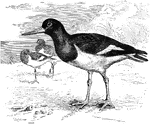
European Oyster-catcher
"Haematopus ostrilegus. European Oyster-catcher. (oyster-opener would b a better name, as oysters do…
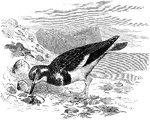
Turnstone
"Strepsilas interpres. Turnstone. Brant Bird. Calico-back. Pied above with black, white, brown, and…

Avocets Head and Foot
"Another small family, characterized by the extreme length of the slender legs, and the extreme slenderness…

Avocets
"Recurvirostra. Avocets. Bell slender, more or less recurved, then the upper mandible hooked at the…
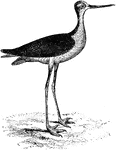
Stilt
"Himantopus. Stilts. Bill extremely slender, but not flattened, nor turned up, nor hooked; longer than…

Black-necked Stilt
"Stilt. Long-shanks. Lawyer. Adult. Mantle, constituted by the interscapulars, scapulars, and wings…

Wilson's Phalarope
"Steganopus wilsoni. Wilson's Phalarope. Bill and feet black. Crown of head pale ash, passing into white…
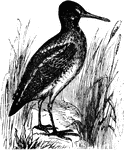
English Snipe
"Gallinago media. European Snipe. English Snipe. In size, form, and general coloration indistinguishable…
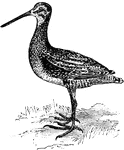
Small Wilson's Snipe
"Gallinago wilsoni. American Snipe. Wilson's Snipe. "English" Snipe. Jack-Snipe. Crown black, with a…
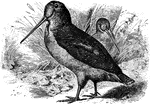
American Woodcock
"Philohela minor. Woodcock. Bog-sucker. Colors above harmoniously blended and varied black, brown, gray,…

Wilson's Snipe
"Gallinago wilsoni. American Snipe. Wilson's Snipe. "English" Snipe. Jack-Snipe. Crown black, with a…

Probing American Woodcock
"Philohela minor. Woodcock. Bog-sucker. Colors above harmoniously blended and varied black, brown, gray,…

American Woodcock Head
"Philohela. American Woodcock. First three primaries emarginate, attenuate and falcate, abruptly shorter…
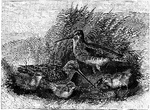
Family of Snipes
"Gallinago wilsoni. American Snipe. Wilson's Snipe. "English" Snipe. Jack-Snipe. Crown black, with a…
Red-breasted Snipe Head
"Macrorhamphus griseus. Red-breasted Snipe. Gray Snipe. Brown-back. Dowitcher. In summer:Under parts…
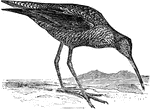
Stilt Sandpiper
"Micropalama himantopus. Stilt Sandpiper. In summer: blackish, each feather edged and tipped with white…
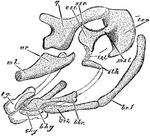
House Martin Skull
"The post-oral arches of the house martin, at middle of period of incubation, lateral view, X14 diameters.…

The Skull of a Chick Stage Two
"Skull of chick, second stage, in profile, brain and membranes removed to show cartilaginous formations,…

The Skull of a Chick Stage Three
"Skull of chick, third stage, viewed from below, x6 & 2/3 diameters. pn, prenasal cartilage, running…
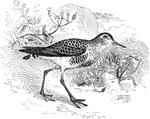
Sanderling
"Calidris arenaria. Sanderling. Ruddy "Plover". Adult in summer: Entire upper parts and neck all round…
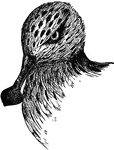
Spoon-billed Sandpiper
"Eurynorhynchus pygmaeus. Spoon-billed Sandpiper. General appearance of a stint, and size little greater.…
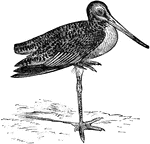
Marbled Godwit
"Limosa fedoa. Great Marbled Godwit. Marlin. Feathers not extending on side of lower mandible to a point…

Willet Head
"Symphemia semipalmata. Semipalmated Tattler. Willet. Adult in summer: Upper parts ashy, confoundedly…
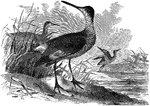
Willets
"Symphemia semipalmata. Semipalmated Tattler. Willet. Adult in summer: Upper parts ashy, confoundedly…

Greater Yello-shanks
"Totanus melanoleucus. Greater Tell-tale. Greater Yellow-shanks. Long-legged Tattler. Stone-snipe. Bill…

Solitary Sandpiper
"Rhyacophilus solitarius. Solitary Tattler. American Green Sandpiper. Solitary Sandpiper. Above, dark…

Spotted Sandpiper
"Tringoides macularius. Spotted Sandpiper. Above, silken ashen-olive (quaker-color- as in our cuckoos)…
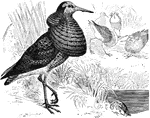
Ruff
"Machetes pugnax. Ruff. Reeve. Combatant. Gambetta. Varied above with black, brown, buff and chestnut,…

Buff-breasted Sandpiper
"Tryngites rufescens. Buff-breasted Sandpiper. Above, brownish-black with a greenish gloss, every feather…
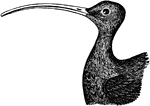
long-billed Curlew
"Numenius longirostris. Long-billed Curlew. Sickle-bill. Plumage very similar to that of the Godwit,…
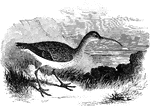
Hudsonian Curlew
"Numenius hudsonicus. Hudsonian Curlew Jack Curlew. General tone of coloration scarcely rufous, the…

Bittern
"Botaurus. Bittern. Bill moderately longer than head, shorter than tarsus, which is shorter than middle…
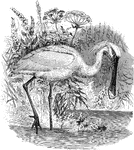
European Spoonbill
"European Spoonbill. Platalea leucorodia. Bill long, flat, remarkably widened, rounded, and spoon-shaped…
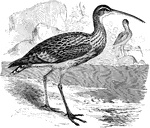
Eurasian Curlew
"Numenius arquatus. Eurasian Curlew. European Curlew. Bill of very variably length, always longer than…
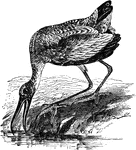
Wood Ibis
"Tantalops loculator. American Wood Stork. Wood Ibis. Colorado Turkey. Plumage white, the wing-quills,…
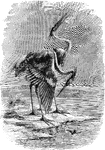
Heron
"Ardea. Great Herons. Of largest size, former well feathered all around. Tibia extensively denuded below.…
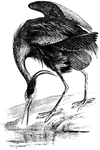
Great Blue Heron
"Ardea herodias. Great Blue Heron. Of large size, and varied dark colors, not dichromatic. Back without…

European Great White Egret
"Herodias. Great Egret Heron. Character of Ardea proper, excepting in plumage; color white; no crest;…
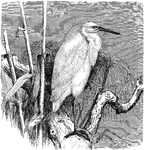
European Little White Egret
"Garzetta. Small Egret Herons. Color white; and occipital crest, and short recurved train of stiff-shafted…
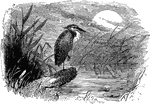
Night Heron
"Nyctiardea grisea naevia. Black-crowned Night Heron. Qua-bird. Squawk. Crown, scapulars and interscapulars…

The Bill of a Bittern
"Botaurus. Bittern. Bill moderately longer than head, shorter than tarsus, which is shorter than middle…
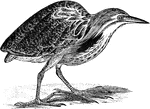
American Bittern
"Botaurus mugitans. American Bittern. Indian Hen. Stake-driver. Bog-Bull. Plumage of the upper parts…
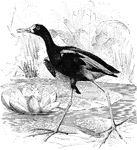
Parra Jacana
"Parra. Jacanas. Bill plover-like, contracted in continuity, enlarged terminally; with culmen depressed…
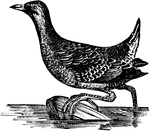
Small Carolina Rail
"Porzana carolina. Carolina Crake. Common Rail. "ortolan." Above, olive-brown, varied with black, with…
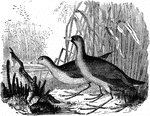
Carolina Rail
"Porzana carolina. Carolina Crake. Common Rail. "ortolan." Above, olive-brown, varied with black, with…

Clapper Rail
"Rallus longirostris crepitans. Clapper Rail. Salt-water Marsh-hen. Mud-hen. Above, variegated with…
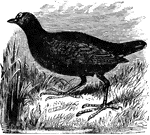
Gallinule
"Gallinula. Gallinules. Water Hens. Mud Hens. Bill not longer than head, stout at base, tapering, compressed,…

Coot Head
"Fulicia. Coot. Bill and frontal plate much as in the Gallinultes. Body depressed; the under plumage…
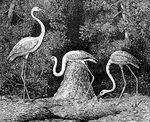
American Flamingo
"Phoinikopteros ruber. American Red Flamingo. Adult: Plumage scarlet, the primaries and most of the…
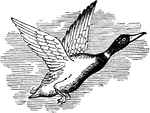
Wild Duck
"Anus boscas. Mallard. Wild or Domestic Duck. Green-head. Bill greenish-yellow. Feet orange-red. Iris…
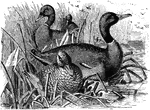
Mallards
"Anus boscas. Mallard. Wild or Domestic Duck. Green-head. Bill greenish-yellow. Feet orange-red. Iris…

Mute Swan
"Cygynus. White Swans. Neck of extreme length. Trachea normally entering sternum. Bill tuberculate or…
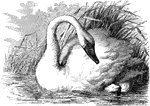
Whistling Swan
"Cygnus columbianus. Common American Swan. Whistling Swan. Bill with a yellow spot or blotch in front…

Black Brant Head
"Bernicla nigricans. Black Brant. Bill, feet, and claws black; iris brown. Head and neck all around,…

Black Brant
"Bernicla nigricans. Black Brant. Bill, feet, and claws black; iris brown. Head and neck all around,…
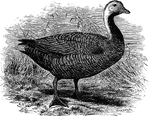
Emperor Goose
"Philacte canagica. Painted Goose. Emperor Goose. Wavy bluish-gray, with lavender or lilac tinting,…
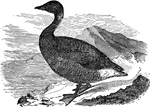
Common Brant
"Bernicla brenta. Brant Goose. Bill, feet, and claws black; iris brown. Head and neck all around, and…
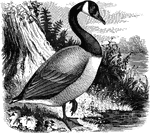
Canada Goose
"Bernicla canadensis. Canada Goose. Common Wild Goose. Tail normally 18-feathered. Bill, feet, head,…

Pin-tail Duck Head
"Dafila. Pin-tail Ducks. Tail (in adult male) narrow, cuneate, when fully developed nearly as long as…

Pin-tail Ducks
"Dafila acuta. Pin-tail Duck. Sprig-tail. Bill black, with grayish-blue edge of upper mandible; feet…